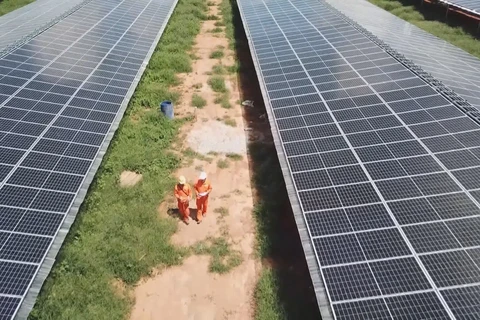 Installing roof-top solar power system at a household in Binh Chanh district, Ho Chi Minh City (Photo: VNA)
Installing roof-top solar power system at a household in Binh Chanh district, Ho Chi Minh City (Photo: VNA) Cao Tung Son, Head of the Hydrometeorology and Climate Change Office under the municipal Department of Natural Resources and Environment, said that the city has cooperated with the US Agency for International Development (USAID) in implementing a project to develop Vietnam Urban Energy Security (VUES).
The project aims to support facilities with large GHG emissions, improving the city’s capacity to build its annual greenhouse gas inventory reports, seeking measures to use water effectively in public facilities and works. Besides, it also focuses on supporting the city in building a roadmap to achieve net-zero emissions.
According to the VUES research team which helps HCM City build its emission reduction plan, the city’s GHG emissions are expected to be reduced to about 245 million tonnes of CO2 by 2050, with the energy using sectors alone emitting about 241.3 million tonnes of CO2. The team underlined the urgent need to speed up green development solutions and efforts to reduce GHG emissions.
Prof. Dr. Ho Quoc Bang, head of the team, said that it has analysed experiences from many cities in the world, including Copenhagen (Denmark), Tokyo (Japan), Kolkata (India) during the building of the plan, and deciding that the city needs to promote the development of rooftop solar power, offshore wind power and power generated from waste, while implementing economic restructuring towards stepping up clean production industries.
In 2018, industry was the largest source of emissions in HCM City, accounting for 34.5% of total emissions, followed by traffic, commerce, and households. By 2050, the commercial sector is predicted to be the largest source of emissions, while industry is likely to rank second, followed by transport, he noted.
The city can pilot special mechanisms to boost the growth of green energy and renewable energy, and implement green transformation, he recommended.
Dr. Pau Dargusch, from Australia’s Queensland University who is a consultant for the VUES project, held that in order to implement an effective carbon offset mechanism, HCM City should establish an agency to act as a contact point in the field, with a clear mission and governance structure different from other state administrative management agencies.
In the short term, the agency can identify projects that can be implemented quickly and easily, he said, adding that in the longer term, it will develop collaborative initiatives with private organisations to help them estimate their carbon accounts and seek and implement emissions reduction projects.
Under the project’s framework, the city has organised three training courses for local firms on greenhouse gas inventory, while supporting 10 enterprises in building their GHG inventory reports and giving advice on water saving to a number of public buildings and works.
It has signed an agreement with the World Bank to implement the activities of the Low Carbon Emissions Technical Group, while carrying out project TA9608 - REG on Strengthening Knowledge and Actions for Air Quality Improvement funded by the Asian Development Bank, and coordinating with the Department of Environmental Engineering of Osaka (Japan) to implement the low carbon emission city development programme./.
VNA























